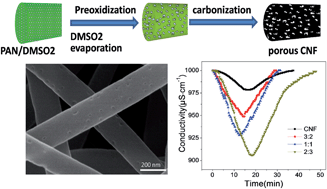Facile fabrication of porous carbon nanofibers by electrospun PAN/dimethyl sulfone for capacitive deionization†
Abstract
This paper reports a facile method to fabricate porous carbon nanofibers (PCNFs) via electrospinning polyacrylonitrile/dimethyl sulfone (PAN/DMSO2) pristine fibers followed by preoxidation and carbonization. The nanopores were produced due to the removal of DMSO2 during the preoxidation process of the nanofibers, without additional chemical or physical activation processes involved. The specific surface and pore density were tunable by varying the PAN/DMSO2 ratio. The variation in the structure and composition of the nanofibers after heat treatment was characterized by scanning electron microscopy, Fourier transform infrared spectroscopy and energy dispersive X-ray spectroscopy. As a free-standing electrode material in electrochemical capacitors, the PCNFs showed an enhanced electrical double layer capacitance characteristic, confirmed by cyclic voltammetry. The PCNFs were used successfully for capacitive deionization (CDI) with an enhanced desalination amount of 8.1 mg g−1, 4.5 times higher than that of pure PAN-based CNFs. The good stability demonstrated that these porous carbon nanofibers could be deployed for CDI application.


 Please wait while we load your content...
Please wait while we load your content...